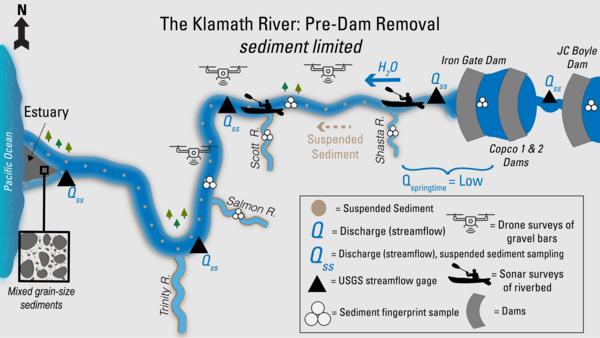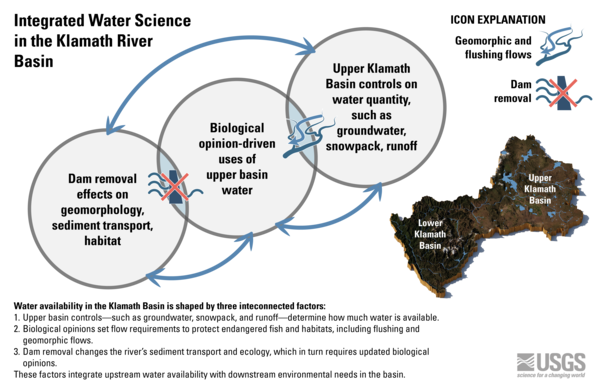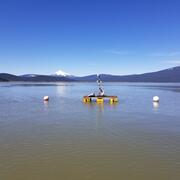Before image: This illustration shows USGS work on the Klamath River and its main tributaries before the dams were removed. Iron Gate, Copco 1 and 2, and JC Boyle Dams blocked the river’s flow and trapped sediment. As a result, only small amounts of suspended sediment made it downstream, and springtime flows were low.
Liam Schenk
Liam Schenk is a Science Advisor at the USGS Oregon Water Science Center.
Liam has been a hydrologist with the Oregon Water Science center since 2011, with prior work as a hydrologic technician and hydrologist at the USGS Arkansas Water Science Center from 2008-2011. Liam manages, conducts, and collaborates on water quality and hydrologic studies in cooperation with federal, state, and local agencies and tribal organizations.
Liam is currently the project manager for the Klamath regional Integrated Water Availability Assessment (IWAA), which includes managing research teams examining controls on water availability in the upper Klamath basin, and the geomorphic response to the largest dam removal in U.S. history on the Klamath River. He also manages the monitoring network for the Klamath dam removals, as part of a cooperative agreement with the Karuk Tribe of California.
Liam has conducted a variety of studies in both fluvial and lentic environments on water quality, sediment and nutrient transport, sediment fingerprinting, sediment transport during deep reservoir drawdowns and dam removal, and mercury in surface waters. He has worked on projects across Oregon, including in the Upper Willamette, Deschutes, Malheur, and Klamath basins and has worked internationally for the USGS Office of International Programs on the Río Coca project in Ecuador.
Education and Certifications
B.Sc. in Mining Engineering from Colorado School of Mines
M.S. in Geology from the University of Arkansas
Science and Products
Nutrient and Sediment Loading to Upper Klamath Lake
Integrating water availability in the Klamath Basin: from drought to dam removal
Upper Klamath Basin Studies and Data Collection
Klamath Dam Removal Studies
Sediment Fingerprinting in the Upper Klamath Basin
Nutrient Loading to Lost River and Klamath River Subbasins
Fall Creek Drawdown
Model Archive Summary for Suspended Sediment Concentration at station 11510700, Klamath River below John C. Boyle Powerplant, near Keno, OR, October 2023 to February 2025 Model Archive Summary for Suspended Sediment Concentration at station 11510700, Klamath River below John C. Boyle Powerplant, near Keno, OR, October 2023 to February 2025
Model Archive Summary for Suspended-Sediment Concentration at station 11509500, Klamath River at Keno, Oregon, water years 2019-2024 Model Archive Summary for Suspended-Sediment Concentration at station 11509500, Klamath River at Keno, Oregon, water years 2019-2024
Sediment grain-size data from the Klamath River estuary, California Sediment grain-size data from the Klamath River estuary, California
Model archive summary for suspended-sediment concentration at station 11516530, Klamath River below Iron Gate Dam, California, WY 2019-2023 Model archive summary for suspended-sediment concentration at station 11516530, Klamath River below Iron Gate Dam, California, WY 2019-2023
Model Archive Summary for Suspended-Sediment Concentration at station 11510700, Klamath River below John C. Boyle power plant, near Keno, OR, water years 2019-2023 Model Archive Summary for Suspended-Sediment Concentration at station 11510700, Klamath River below John C. Boyle power plant, near Keno, OR, water years 2019-2023
Turbidity and Suspended Sediment Concentration Data from a Laboratory Mixing Tank Experiment 2023 (ver. 1.1, November 2024) Turbidity and Suspended Sediment Concentration Data from a Laboratory Mixing Tank Experiment 2023 (ver. 1.1, November 2024)
Input and results from boosted regression tree and artificial neural network models that predict daily maximum pH and daily minimum dissolved oxygen in Upper Klamath Lake, 2005-2019 Input and results from boosted regression tree and artificial neural network models that predict daily maximum pH and daily minimum dissolved oxygen in Upper Klamath Lake, 2005-2019
Model Archive Summary for Suspended-Sediment Concentration at USGS site 11502500, Williamson River below Sprague River near Chiloquin, OR Model Archive Summary for Suspended-Sediment Concentration at USGS site 11502500, Williamson River below Sprague River near Chiloquin, OR
Model Archive Summary for Suspended-Sediment Concentration at station 11501000, Sprague River near Chiloquin, OR WY 2008-2017 revision and computation for WY 2008-2020 Model Archive Summary for Suspended-Sediment Concentration at station 11501000, Sprague River near Chiloquin, OR WY 2008-2017 revision and computation for WY 2008-2020
Bed material grain size distributions for surficial samples from Iron Gate, Copco, and J.C. Boyle Reservoirs Bed material grain size distributions for surficial samples from Iron Gate, Copco, and J.C. Boyle Reservoirs


Before image: This illustration shows USGS work on the Klamath River and its main tributaries before the dams were removed. Iron Gate, Copco 1 and 2, and JC Boyle Dams blocked the river’s flow and trapped sediment. As a result, only small amounts of suspended sediment made it downstream, and springtime flows were low.

Integrated Water Science in the Klamath River Basin, Diagram
Integrated Water Science in the Klamath River Basin, DiagramWater availability in the Klamath Basin is shaped by three interconnected factors, like overlapping circles in a Venn diagram. First, upper basin controls—such as groundwater, snowpack, and runoff—determine how much water is available. Second, biological opinions set flow requirements to protect endangered fish and habitats, including flushing and geomorphic flows.
Integrated Water Science in the Klamath River Basin, Diagram
Integrated Water Science in the Klamath River Basin, DiagramWater availability in the Klamath Basin is shaped by three interconnected factors, like overlapping circles in a Venn diagram. First, upper basin controls—such as groundwater, snowpack, and runoff—determine how much water is available. Second, biological opinions set flow requirements to protect endangered fish and habitats, including flushing and geomorphic flows.

Iron Gate Dam and Hatchery, Klamath River, California
Iron Gate Dam and Hatchery, Klamath River, CaliforniaAerial view of the Iron Gate Dam and Hatchery along the Klamath River near Hornbrook, California. A series of hydroelectric facilities (JC Boyle, Copco No. 1, Copco No. 2, and Iron Gate) separate the Klamath River into upper and lower basins.
Iron Gate Dam and Hatchery, Klamath River, California
Iron Gate Dam and Hatchery, Klamath River, CaliforniaAerial view of the Iron Gate Dam and Hatchery along the Klamath River near Hornbrook, California. A series of hydroelectric facilities (JC Boyle, Copco No. 1, Copco No. 2, and Iron Gate) separate the Klamath River into upper and lower basins.
2022 McKinney rain-on-wildfire event, dissolved oxygen sags, and a fish kill on the Klamath River, California 2022 McKinney rain-on-wildfire event, dissolved oxygen sags, and a fish kill on the Klamath River, California
Total phosphorus and suspended-sediment concentrations and loads from two main tributaries to Upper Klamath Lake, Oregon, 2014–20 Total phosphorus and suspended-sediment concentrations and loads from two main tributaries to Upper Klamath Lake, Oregon, 2014–20
Reservoir evolution, downstream sediment transport, downstream channel change, and synthesis of geomorphic responses of Fall Creek and Middle Fork Willamette River to water years 2012–18 streambed drawdowns at Fall Creek Lake, Oregon Reservoir evolution, downstream sediment transport, downstream channel change, and synthesis of geomorphic responses of Fall Creek and Middle Fork Willamette River to water years 2012–18 streambed drawdowns at Fall Creek Lake, Oregon
Examining the effect of physicochemical and meteorological variables on water quality indicators of harmful algal blooms in a shallow hypereutrophic lake using machine learning techniques Examining the effect of physicochemical and meteorological variables on water quality indicators of harmful algal blooms in a shallow hypereutrophic lake using machine learning techniques
Sediment transport, turbidity, and dissolved oxygen responses to annual streambed drawdowns for downstream fish passage in a flood control reservoir Sediment transport, turbidity, and dissolved oxygen responses to annual streambed drawdowns for downstream fish passage in a flood control reservoir
Effects of harmful algal blooms and associated water-quality on endangered Lost River and shortnose suckers Effects of harmful algal blooms and associated water-quality on endangered Lost River and shortnose suckers
Monitoring the effect of deep drawdowns of a flood control reservoir on sediment transport and dissolved oxygen, Fall Creek Lake, Oregon Monitoring the effect of deep drawdowns of a flood control reservoir on sediment transport and dissolved oxygen, Fall Creek Lake, Oregon
Differentiating sediment sources using sediment fingerprinting techniques, in the Sprague River Basin, South-Central Oregon Differentiating sediment sources using sediment fingerprinting techniques, in the Sprague River Basin, South-Central Oregon
Refining the Baseline Sediment Budget for the Klamath River, California Refining the Baseline Sediment Budget for the Klamath River, California
Nutrient loads in the Lost River and Klamath River Basins, south-central Oregon and northern California, March 2012–March 2015 Nutrient loads in the Lost River and Klamath River Basins, south-central Oregon and northern California, March 2012–March 2015
Evaluating external nutrient and suspended-sediment loads to Upper Klamath Lake, Oregon, using surrogate regressions with real-time turbidity and acoustic backscatter data Evaluating external nutrient and suspended-sediment loads to Upper Klamath Lake, Oregon, using surrogate regressions with real-time turbidity and acoustic backscatter data
Comparison of mercury mass loading in streams to atmospheric deposition in watersheds of Western North America: Evidence for non-atmospheric mercury sources Comparison of mercury mass loading in streams to atmospheric deposition in watersheds of Western North America: Evidence for non-atmospheric mercury sources
Science and Products
Nutrient and Sediment Loading to Upper Klamath Lake
Integrating water availability in the Klamath Basin: from drought to dam removal
Upper Klamath Basin Studies and Data Collection
Klamath Dam Removal Studies
Sediment Fingerprinting in the Upper Klamath Basin
Nutrient Loading to Lost River and Klamath River Subbasins
Fall Creek Drawdown
Model Archive Summary for Suspended Sediment Concentration at station 11510700, Klamath River below John C. Boyle Powerplant, near Keno, OR, October 2023 to February 2025 Model Archive Summary for Suspended Sediment Concentration at station 11510700, Klamath River below John C. Boyle Powerplant, near Keno, OR, October 2023 to February 2025
Model Archive Summary for Suspended-Sediment Concentration at station 11509500, Klamath River at Keno, Oregon, water years 2019-2024 Model Archive Summary for Suspended-Sediment Concentration at station 11509500, Klamath River at Keno, Oregon, water years 2019-2024
Sediment grain-size data from the Klamath River estuary, California Sediment grain-size data from the Klamath River estuary, California
Model archive summary for suspended-sediment concentration at station 11516530, Klamath River below Iron Gate Dam, California, WY 2019-2023 Model archive summary for suspended-sediment concentration at station 11516530, Klamath River below Iron Gate Dam, California, WY 2019-2023
Model Archive Summary for Suspended-Sediment Concentration at station 11510700, Klamath River below John C. Boyle power plant, near Keno, OR, water years 2019-2023 Model Archive Summary for Suspended-Sediment Concentration at station 11510700, Klamath River below John C. Boyle power plant, near Keno, OR, water years 2019-2023
Turbidity and Suspended Sediment Concentration Data from a Laboratory Mixing Tank Experiment 2023 (ver. 1.1, November 2024) Turbidity and Suspended Sediment Concentration Data from a Laboratory Mixing Tank Experiment 2023 (ver. 1.1, November 2024)
Input and results from boosted regression tree and artificial neural network models that predict daily maximum pH and daily minimum dissolved oxygen in Upper Klamath Lake, 2005-2019 Input and results from boosted regression tree and artificial neural network models that predict daily maximum pH and daily minimum dissolved oxygen in Upper Klamath Lake, 2005-2019
Model Archive Summary for Suspended-Sediment Concentration at USGS site 11502500, Williamson River below Sprague River near Chiloquin, OR Model Archive Summary for Suspended-Sediment Concentration at USGS site 11502500, Williamson River below Sprague River near Chiloquin, OR
Model Archive Summary for Suspended-Sediment Concentration at station 11501000, Sprague River near Chiloquin, OR WY 2008-2017 revision and computation for WY 2008-2020 Model Archive Summary for Suspended-Sediment Concentration at station 11501000, Sprague River near Chiloquin, OR WY 2008-2017 revision and computation for WY 2008-2020
Bed material grain size distributions for surficial samples from Iron Gate, Copco, and J.C. Boyle Reservoirs Bed material grain size distributions for surficial samples from Iron Gate, Copco, and J.C. Boyle Reservoirs


Before image: This illustration shows USGS work on the Klamath River and its main tributaries before the dams were removed. Iron Gate, Copco 1 and 2, and JC Boyle Dams blocked the river’s flow and trapped sediment. As a result, only small amounts of suspended sediment made it downstream, and springtime flows were low.
Before image: This illustration shows USGS work on the Klamath River and its main tributaries before the dams were removed. Iron Gate, Copco 1 and 2, and JC Boyle Dams blocked the river’s flow and trapped sediment. As a result, only small amounts of suspended sediment made it downstream, and springtime flows were low.

Integrated Water Science in the Klamath River Basin, Diagram
Integrated Water Science in the Klamath River Basin, DiagramWater availability in the Klamath Basin is shaped by three interconnected factors, like overlapping circles in a Venn diagram. First, upper basin controls—such as groundwater, snowpack, and runoff—determine how much water is available. Second, biological opinions set flow requirements to protect endangered fish and habitats, including flushing and geomorphic flows.
Integrated Water Science in the Klamath River Basin, Diagram
Integrated Water Science in the Klamath River Basin, DiagramWater availability in the Klamath Basin is shaped by three interconnected factors, like overlapping circles in a Venn diagram. First, upper basin controls—such as groundwater, snowpack, and runoff—determine how much water is available. Second, biological opinions set flow requirements to protect endangered fish and habitats, including flushing and geomorphic flows.

Iron Gate Dam and Hatchery, Klamath River, California
Iron Gate Dam and Hatchery, Klamath River, CaliforniaAerial view of the Iron Gate Dam and Hatchery along the Klamath River near Hornbrook, California. A series of hydroelectric facilities (JC Boyle, Copco No. 1, Copco No. 2, and Iron Gate) separate the Klamath River into upper and lower basins.
Iron Gate Dam and Hatchery, Klamath River, California
Iron Gate Dam and Hatchery, Klamath River, CaliforniaAerial view of the Iron Gate Dam and Hatchery along the Klamath River near Hornbrook, California. A series of hydroelectric facilities (JC Boyle, Copco No. 1, Copco No. 2, and Iron Gate) separate the Klamath River into upper and lower basins.








